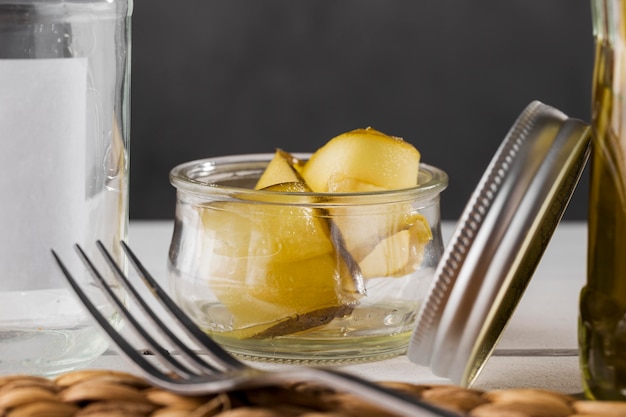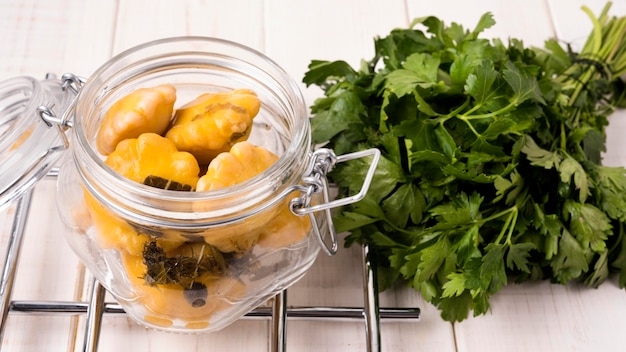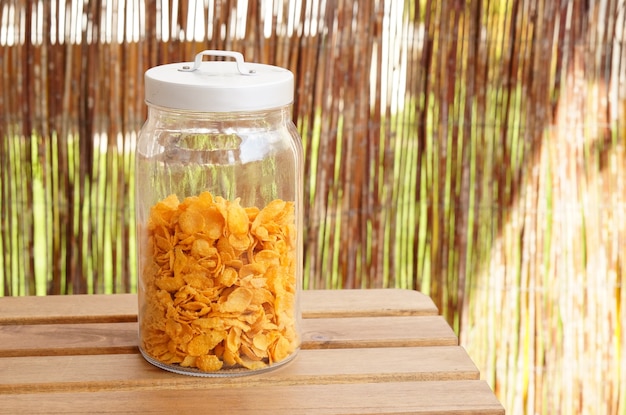Remember that time you hesitantly nibbled on a hot dog, wondering what that tangy, fermented topping was all about? That, my friends, was sauerkraut. For years, it was just a side dish to me, a fleeting encounter on a fast-food plate. But then, I discovered the magic of homemade sauerkraut, and it changed everything. It's a flavour revelation, a taste explosion, a revelation of a whole new culinary dimension. And guess what? It's ridiculously simple to make. Join me on my journey into the world of sauerkraut, and let's explore some easy recipes that will have you hooked in no time.
(Part 1) Sauerkraut: A Fermented Delight

Imagine a symphony of flavours, a blend of tart and tangy, with hints of earthiness and spice. That’s sauerkraut in a nutshell. It’s simply fermented cabbage, but the result is far more complex than the sum of its parts. It's a traditional dish with roots in Eastern Europe, and for centuries, people have savoured its unique taste and appreciated its health benefits.
Why I Fell in Love with Sauerkraut
My sauerkraut awakening was a gradual process. It began with a bit of curiosity, a desire to experiment with fermenting food at home. Sauerkraut seemed like the perfect starting point - easy, accessible, and intriguing. And boy, was I in for a treat! The homemade version was a complete revelation - a flavour explosion unlike anything I'd ever tasted from a jar. It had this incredible depth, this complexity, that just couldn't be replicated in store-bought sauerkraut. Plus, it’s a powerhouse of good bacteria, a boon for your gut health.
Sauerkraut: A Culinary Chameleon
Beyond its incredible flavour, sauerkraut is incredibly versatile. It’s not just for hot dogs! It shines in salads, sandwiches, and soups, adds a vibrant punch to grilled meats and fish, and even stars in innovative gourmet dishes. My kitchen has become a playground for sauerkraut experimentation, and I’m constantly discovering new and delicious ways to use it.
(Part 2) From Jar to Fermenter: A Sauerkraut Journey

My sauerkraut journey has been a fascinating evolution, from simple beginner experiments to more sophisticated methods. It all started with a humble glass jar, followed by a traditional sauerkraut crock, and finally, the convenience of a glass fermenting jar. Each step has been a learning curve, revealing the secrets of fermentation and the incredible variety of flavours that can be achieved.
The Simple Jar Method: A Great Starting Point
This is where I took my first tentative steps into the world of sauerkraut. It’s a perfect starting point for anyone curious about fermentation. All you need is a clean glass jar, some cabbage, salt, and a little patience. You'll be amazed at how quickly your humble cabbage transforms into a delicious tangy treat.
Here’s a simple recipe to get you started:
- Shred your cabbage finely. This is key, as it allows the salt to penetrate the cabbage and the brine to develop properly.
- Pack it tightly into a clean glass jar, adding salt as you go. I use about 2 tablespoons of salt per 1 kg of cabbage. The salt draws out the moisture from the cabbage, creating a brine that keeps unwanted bacteria at bay.
- Press down on the cabbage to release more moisture and ensure it’s submerged in the brine. This is essential for proper fermentation. You can use a weight like a small plate or a clean stone to keep the cabbage submerged.
- Cover the jar with a cloth or a breathable lid, and place it in a cool, dark place for 1-2 weeks. Check the jar every day or so to ensure that the cabbage is submerged in the brine. If it’s not, add more salt or adjust the weight to help it sink.
- Once the sauerkraut is fermented to your liking, you can store it in the refrigerator for up to a month.
Sauerkraut Crocks: Embracing Tradition
Sauerkraut crocks are a classic choice for fermenting sauerkraut, and they’ve been around for centuries. They are designed to hold larger batches, with a wide opening and a weighted lid that keeps the cabbage submerged. The lid often has a groove to allow gases to escape during fermentation. These crocks are a beautiful reminder of the history and tradition associated with sauerkraut.
Glass Fermentation Jars: Modern Convenience
My current favourite method involves using glass fermentation jars, which are specifically designed for fermenting. They come with a lid that has an airlock, a clever mechanism that allows gases to escape while preventing air from entering, ensuring a smooth fermentation process. These jars are also incredibly easy to clean and look great on your kitchen counter, adding a touch of elegance to your fermentation process.
(Part 3) Mastering the Art of Sauerkraut: Tips and Tricks

Once you've made your first batch of sauerkraut, you’ll be eager to experiment with different flavours and techniques. Here are some tips to elevate your sauerkraut game.
Experimenting with Flavours: Beyond the Basics
The beauty of sauerkraut lies in its customizability. You can add different spices, herbs, and vegetables to create unique flavour combinations. Caraway seeds are a classic addition, imparting a warm, earthy note. Other delicious options include juniper berries, dill seeds, mustard seeds, and fresh herbs like thyme or rosemary. Remember to add your chosen flavourings after the cabbage has been shredded and before you pack it into the jar.
Understanding Fermentation Time: The Art of Patience
The fermentation time for sauerkraut can vary depending on the temperature and your desired level of tanginess. Generally, it takes about 1-2 weeks for sauerkraut to ferment. But you can leave it for longer if you prefer a more intense sour flavour. Keep in mind that the sauerkraut will continue to ferment in the refrigerator, just at a slower pace.
The Importance of Salt: The Key to a Successful Fermentation
Salt is the secret ingredient that makes sauerkraut possible. It draws moisture out of the cabbage, creating a brine that prevents harmful bacteria from growing. The right amount of salt is crucial. Too little, and the sauerkraut might spoil. Too much, and it will taste too salty. I recommend starting with 2 tablespoons of salt per 1 kg of cabbage, but you can always adjust based on your taste preferences.
(Part 4) Sauerkraut Recipes: From Simple to Spectacular
Let’s dive into some mouthwatering sauerkraut recipes. From simple classics to more adventurous flavour combinations, there's something for every palate.
Classic Sauerkraut: A Time-Honoured Recipe
This is a fundamental sauerkraut recipe, a great starting point for anyone venturing into the world of fermentation.
Ingredients
- 1 kg green cabbage
- 2 tablespoons sea salt
- 1 teaspoon caraway seeds
Instructions
- Shred the cabbage finely.
- Pack the shredded cabbage tightly into a clean glass jar, adding the salt and caraway seeds as you go.
- Press down on the cabbage to release moisture and ensure it is fully submerged in the brine.
- Cover the jar with a cloth or a breathable lid, and place it in a cool, dark place for 1-2 weeks, or until the sauerkraut is fermented to your liking.
- Once the sauerkraut is fermented, store it in the refrigerator for up to a month.
Spicy Sauerkraut: A Touch of Heat
For those who crave a bit of fiery kick, this recipe delivers. It adds chili flakes to the classic sauerkraut for a spicy punch.
Ingredients
- 1 kg green cabbage
- 2 tablespoons sea salt
- 1 teaspoon caraway seeds
- 1/2 teaspoon red pepper flakes
Instructions
- Follow the instructions for the classic sauerkraut recipe, adding the red pepper flakes to the cabbage along with the salt and caraway seeds.
Apple and Fennel Sauerkraut: A Sweet and Savoury Delight
This recipe is a symphony of flavours, combining the sweetness of apple with the anise flavour of fennel for a truly unique and delicious sauerkraut.
Ingredients
- 1 kg green cabbage
- 2 tablespoons sea salt
- 1/2 cup diced apple
- 1/4 cup chopped fennel
- 1 teaspoon caraway seeds
Instructions
- Follow the instructions for the classic sauerkraut recipe, adding the diced apple, chopped fennel, and caraway seeds to the cabbage along with the salt.
Sauerkraut Salad: A Light and Refreshing Option
This is a perfect salad for a light lunch or dinner, featuring sauerkraut as the star ingredient. It’s a vibrant blend of textures and flavours.
Ingredients
- 1 cup sauerkraut
- 1 cup shredded red cabbage
- 1/2 cup chopped carrots
- 1/4 cup chopped fresh parsley
- 2 tablespoons olive oil
- 1 tablespoon lemon juice
- Salt and pepper to taste
Instructions
- In a large bowl, combine the sauerkraut, red cabbage, carrots, and parsley.
- In a small bowl, whisk together the olive oil, lemon juice, salt, and pepper.
- Pour the dressing over the salad and toss to combine.
- Serve immediately.
(Part 5) Sauerkraut: More Than Just a Fermented Cabbage
As my love for sauerkraut deepened, I discovered that it’s not just a delicious food, it’s also a powerhouse of nutrients and gut-friendly bacteria. It’s a true superfood!
The Gut Health Benefits of Sauerkraut: A Boon for Digestion
The fermentation process creates a rich source of probiotics, live bacteria that are essential for a healthy gut. These probiotics work wonders for your digestive system, helping to improve digestion, boost your immune system, and even reduce inflammation. They are like tiny warriors, keeping your gut in tip-top shape.
The Nutritional Value of Sauerkraut: Packed with Goodness
Sauerkraut is not only delicious but also packed with essential vitamins and minerals. It's a good source of vitamin C, vitamin K, and fiber. It also contains iron, potassium, and magnesium. So, it’s not just a tasty treat, it’s also a nutritional powerhouse.
(Part 6) Sauerkraut Troubleshooting: Common Problems and Solutions
Fermenting sauerkraut is usually a straightforward process, but there are times when things might go awry. Here are some common problems and their solutions.
Problem: Mold Growth - A Sign of Air Contamination
Mold growth on the surface of the sauerkraut is a sign that air has gotten into the jar, disrupting the fermentation process. While mold is usually harmless, it indicates that something isn’t quite right.
Solution: Skimming, Salting, and Submerging
If you see mold, try to remove it by carefully skimming it off the surface. Then, add more salt to the brine, and press down on the cabbage to ensure it’s submerged. This will help to create a more acidic environment that inhibits mold growth. If the mold is extensive, it’s best to discard the sauerkraut.
Problem: Off-Flavour - A Sign of Imbalance
If your sauerkraut develops an off-flavour, it could be due to several factors, including too much salt, insufficient fermentation, or the presence of unwanted bacteria. It’s important to pinpoint the cause to take appropriate action.
Solution: Adjusting Salt Levels, Extending Fermentation, and Discarding
If the sauerkraut is too salty, you can try rinsing it with water to reduce the saltiness. If it’s under-fermented, it may have a sweet or slightly sour flavour. It can be left to ferment for longer if desired. If you suspect contamination with unwanted bacteria, it’s best to discard the sauerkraut to avoid any potential health risks.
(Part 7) Beyond the Basics: Sauerkraut Variations
Once you’ve mastered the basics of sauerkraut, you can start experimenting with different variations and flavour combinations. The possibilities are endless!
Sauerkraut with Beets: A Vibrant and Earthy Delight
Add some colourful beets to your sauerkraut for a vibrant and flavourful twist. The earthy sweetness of the beets complements the tangy sauerkraut beautifully, creating a delightful contrast of textures and flavours.
Ginger Sauerkraut: A Spicy and Invigorating Twist
Add some grated ginger to your sauerkraut for a spicy and invigorating flavour. Ginger is known for its digestive benefits, so this sauerkraut is perfect for those who enjoy a bit of heat.
Kimchi: Korean Sauerkraut: A World of Flavour
Kimchi is a popular Korean fermented cabbage dish that features a combination of spicy, sour, and umami flavours. It’s often made with gochugaru (Korean chili powder), garlic, ginger, and other ingredients.
(Part 8) Sauerkraut: A culinary journey
My journey with sauerkraut has been a wonderful exploration of flavours and techniques. It's opened up a world of culinary possibilities, and I've learned so much about the art of fermentation. Sauerkraut is a delicious, healthy, and surprisingly versatile food that I encourage everyone to try. It’s truly a food for all seasons and all tastes.
FAQs
1. What is the best type of cabbage to use for sauerkraut?
Green cabbage is the traditional choice for sauerkraut, and it’s the best option for achieving that classic tangy flavour. You can also use red cabbage, which will add a beautiful colour to your sauerkraut.
2. Can I use tap water for sauerkraut?
It’s best to use filtered or bottled water for making sauerkraut. Tap water can contain chlorine, which can affect the fermentation process. If you use tap water, allow it to sit out for 24 hours to let the chlorine dissipate.
3. How long does sauerkraut last?
Once fermented, sauerkraut can be stored in the refrigerator for up to a month. It’s important to keep it submerged in the brine to ensure that it stays fresh.
4. Can I use a different type of salt for sauerkraut?
Sea salt or kosher salt are the best choices for making sauerkraut. Table salt contains additives that can inhibit the fermentation process. Avoid using iodized salt, as the iodine can affect the taste and colour of the sauerkraut.
5. Can I freeze sauerkraut?
It’s not recommended to freeze sauerkraut. Freezing can affect the texture and flavour of the sauerkraut, and it can also cause the brine to separate.
So, what are you waiting for? Grab some cabbage, get your hands dirty, and embark on your own sauerkraut adventure! It's a delicious and rewarding experience that you won’t regret.
Everyone is watching

Perfect Rice Every Time: The Ultimate Guide to Cooking Rice
Cooking TipsAs a self-proclaimed foodie, I've always been a bit obsessed with rice. It's the foundation of countless cuisi...

Prime Rib Roast Cooking Time Chart: Per Pound Guide
Cooking TipsPrime rib roast. Just the name conjures images of lavish dinners, crackling fires, and hearty laughter. It’s ...

The Ultimate Guide to Cooking Asparagus: Tips, Techniques, and Recipes
Cooking TipsAsparagus. The mere mention of this spring delicacy conjures up images of vibrant green spears, crisp and burs...

Ultimate Guide to Cooking the Perfect Thanksgiving Turkey
Cooking TipsThanksgiving. Just the word conjures up images of overflowing tables laden with delicious food, the scent of r...

How Long to Bake Potatoes in the Oven (Perfect Every Time)
Cooking TipsBaked potatoes are a staple in my kitchen. They're incredibly versatile, delicious, and surprisingly easy to m...
